Helena Rubinstein (1915-1930)
Continued from: Helena Rubinstein
Continued onto: Helena Rubinstein (1930-1945)
After arriving in the United States in 1914, Rubinstein toured the country looking for places to set up salons and for suitable outlets to sell her products. Returning to New York, she was joined there by Titus with her two children, and by her sister Mańka who had arrived to help with the development of the American business.
In December, 1914, Rubinstein took out a lease at 15 East 49th Street, New York and, after suitable renovations, opened her first American Maison de Beauté Valaze there in May, 1915. The modernist-influenced interiors and Nadelman sculptures generated a lot of press interest and Rubinstein would repeat this stratagem in the future, using her growing art collection to generate free publicity.
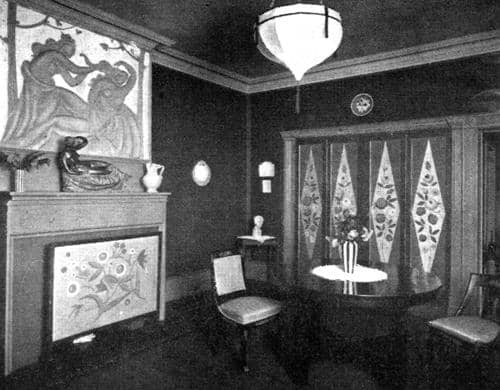
Above: 1915 New York Salon designed by the modernist designer Paul T. Frankl [1886-1958]. The walls were covered with dark-blue cloth with baseboards and mouldings coloured a deep rose. Furniture was made from rosewood and mahogany upholstered in rose silk. The bas relief was designed by the Polish-American sculptor, Elie Nadelman [1882-1946] (Slesin, 2003).
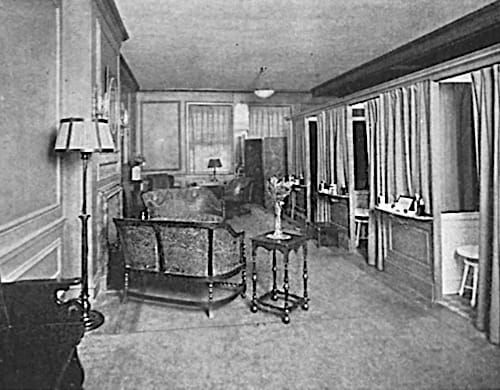
Above: 1915 Waiting corridor with deep tan walls and black and gold hangings. Treatment cubicles to the right, possibly for manicures.
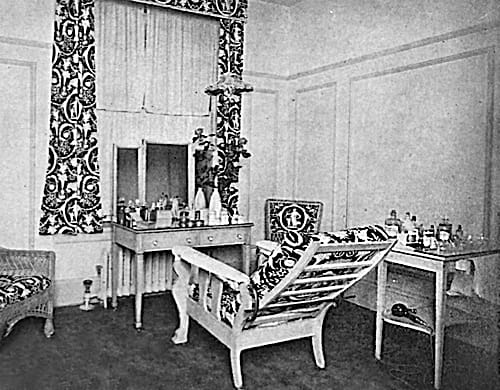
Above: 1915 Major treatment room in the New York salon decorated in black and white chintz fitted out with wicker and white-lacquered furniture (Slesin, 2003).
After New York, Rubinstein opened salons in San Fransisco, Philadelphia and New Orleans (1916), Chicago (1917), Atlantic City (1918) and Boston (1920). By then, she had relocated her New York salon to 46 West 57th Street (1918) and had begun selling her cosmetics through department stores, such as City of Paris in San Francisco and Halle Bothers in Cleveland, as well as select drug stores like the Warner Drug Company in Nashville and the Jermyn Drug Company in Scranton.
In 1916, Rubinstein established the Helena Rubinstein Beauty Products Manufacturing Company, with a capitalisation of US$25,0000, to make Helena Rubinstein cosmetics in the United States and set up a factory at 208 Rawson Street, Long Island City. This reduced the need to import cosmetics from overseas and avoided the associated import duties they incurred but did not stop Rubinstein from claiming or suggesting that her cosmetics were ‘direct from Paris’.
In the United States, Rubinstein described herself as Europe’s famous beauty expert and now said she was Russian rather than Viennese, presumably because Austria had allied with Germany in the war then raging in Europe. Claiming to be the ‘foremost beauty expert’ went hand in hand with downplaying the role that Dr. Lykusky had supposedly played in developing many of her products. She mentions him in some early American advertising but his name is quickly dropped in preference to the Valaze brand; e.g., Dr. Lykuski’s Blackhead and Open Pore Cure was now known as Valaze Blackhead and Open Pore Paste. This was not a new development; Rubinstein had been moving in this direction since 1913 at least. However, Dr. Lykusky did not disappear altogether and Rubinstein continued to recount the myth that he was responsible for the original Valaze cream in all the biographies she ‘authored’.
Skin-care
Most of Rubinstein’s skin-care lines continued to be badged as Valaze. Many were not new and had become part of the Valaze range only through a name change; e.g., Comtesse Potocka’s Creme Promenade was now known as Valaze Creme Promenade.
Some of the newer lines – such as Extrait Georgine, Georgine Lactée and Noir Georgine – may have come with the 1909 purchase of the French business of Madame Georgine de Champbaron. Extrait Georgine and Noir Georgine seem to have disappeared from Rubinstein’s product lines by 1920 but the astringent, Georgine Lactée, used to reduce wrinkles and improve contour lines, was around for much longer.
Other new lines added by 1915 included two skin balms, Baume Vert (Balm Vert) and Baume Blanc (Balm Blanc).
Baume Vert: “[A] balsam intended more particularly for dry, tender, easily roughened skins. It prevents, with the same facility and certainty as it removes, the baneful effects of winds, strong sea air, drying cold or heat on the skin.”
Baume Blanc: “[A] soothing, sedative balsam, that remedies redness, irritation, and soreness of the skin. Its beneficial action is very marked in cases of blotchiness and pimples, and any eruption or bruising of the skin.”
There were also two ‘rejuvenating stimulants’ used to increase the blood flow to the skin.
Eau qui Pique: “[B]rings fresh life to the skin, lashes it to immediate activity, whips the blood close to the surface, floods the cheeks with colour, instantly brightens and lightens, and makes the skin tense to tautness.”
Eau Vert: “[M]uch like Eau qui Pique, but being rather milder, it is more adapted to beginners in treatment, particularly those with dry and sensitive skins.”
Both of these ‘waters’ were used in anti-wrinkle treatments. The milder Eau Vert was recommended for women up to the age of forty or for reducing fine lines, the stronger Eau qui Pique for women older than forty or to treat deeper lines.
Massage
Rubinstein continued to promote massage in her beauty treatments and persisted with the view that self massage was difficult to do properly by hand. The solution to this problem continued to be her mechanical roller, the Valaze Massagette. This was advertised as having the added benefit of not unduly stretching the skin, another commonly believed cause of wrinkles.
[S]killed “face manipulators” are not only rare, but, when found and really expert, worth their weight in gold. … And yet massage should never be a luxury, and it has in reality ceased to be one, since it has become possible for a very small outlay made once for all to be able, by means of the Valaze Massagette, to give one’s face, neck, chin and shoulders that amount of hygienic care and attention for beauty’s and health’s sake that massage alone can well accomplish.
(Helena Rubinstein, c.1915, p. 17)
Elizabeth Arden would have insisted that her Ardena Patter was better.
See also: Elizabeth Arden
Skin types
Rubinstein still classified skin as normal, over-moist (oily) and dry, with each type determined by the relative production of secretions from the skin glands.
The normal velvety gloss of the skin possesses aesthetic significance. It is produced by the evenly measured excretion of the moisture and fat-secreting glands. Abnormal diminution or increase of the secretions make the skin either dry and dull or unduly moist and greasy, whereby in either case the beauty of its lustre, its “enamel”, disappears.
(Helena Rubinstein, c.1915, p. 7)
By 1915, Rubinstein had made a few additions to her skin treatment regimes but still followed her previous practice of cleansing and toning the skin before applying cosmetics to feed and protect it. Following Rubinstein’s recommended treatment required at least four cosmetics, more if different products were used on alternate days, more still if a skin-care routine was followed by make-up.
Taking women with normal skin as an example, Rubinstein recommended that their skin be cleansed with Valaze Complexion Soap combined with Voskpasta, toned with Valaze Skin-toning Lotion or Valaze Extrait, fed with Valaze Beautifying Skinfood, and protected with Valaze Complexion Powder (in summer or at night) or Novena Poudre (when outdoors in winter). Novena Creme could be used to cleanse exposed skin and Valaze Liquidine could be applied once or twice a day in summer on skin prone to perspiration. Valaze Creme Promenade or Valaze Cream of Lillies (Crème de Lilas) was suggested as a finishing or ‘dressing’ cream to give the skin a smooth appearance and/or act as a base for Valaze Complexion Powder, the recommended powder for normal skin types.
For shiny, over-moist skin there was now Valaze Beauty Grains (1915) which could be employed as a stand-alone cleanser or used together, or alternatively with, Valaze Liquidine and/or Valaze Blackhead and Open Pore Paste. The Beauty Grains were mixed with water in the palm of the hand to create a thick paste which was then worked into the skin. Said to be mildly bleaching, they appear to have also acted as a mechanical exfoliant and were also recommended for the hands and rough elbows.
Valaze Beauty Grains: “[K]eeps the skin charmingly pure and alabaster-like in its transparency, improves the skin’s texture, and preserves its velvety touch. It does away with greasiness of the skin, and prevents pores becoming enlarged.”
Clients with dry skin could now use Valaze Skin-Lotion Special to cleanse their skin as an alternative to Novena Cerate, and Anthosoros (later called Grecian Anti-wrinkle Cream) instead of Novena Crème.
Anthosoros: “[A] delightful cream for use round and under the eyes, preventing ‘crows-feet,’ and the tiny lines that too quickly appear.”
Lines and wrinkles
Lines and wrinkles remained a major preoccupation for Rubinstein and, along with her forehead straps, she had a plethora of skin-care products to treat them, many of which had overlapping properties.
Lines caused by sagging skin had to be treated by re-establishing the ‘relaxed tension’ of the face. This required astringents, either Novena Extrait (for greasy skins) or Valaze Extrait (for dry skins), both of which were followed by Georgine Lacteé. Novena Extrait was an older product but Valaze Extrait and Georgine Lacteé were relatively new.
Valaze Extrait: “[A]n antiwrinkle, beautifying balsam that smooths out crow’s-feet and lines, and softens and expands dry, drawn, puckered surfaces. It is especially soothing when applied by means of warm compresses.”
Georgine Lactée: “[A] powerful astringent that tautens relaxed muscles, causes the flesh to resume its firm tension, and smooths out deeply score lines.”
Following cleansing and toning, clients were advised to feed the skin, alternating nightly between Valaze Beautifying Skinfood – as Dr. Lykusky’s Russian Skinfood Valaze was now known – and Novena Crème, massaged into the skin with the fingers or using the Valaze Massagette.
For fine lines and wrinkles around the eyes (crow’s feet) Rubinstein recommended the previously mentioned Eau Vert and Eau qui Pique. To calm the prickling or tingling sensation these products caused, and to add ‘nourishment’, they were followed by the previously mentioned Anthosoros, alternating with Emailline.
Valaze Emailline: “[A] combination of stimulating, emollient, cleansing, skin-toning and tissue-strengthening properties. It is of value to all alike, since it maintains the skin’s purity of tone, its smoothness of texture, and firmness of tension. It moderates lines, wrinkles and looseness, clears the skin, and removes impurities embedded within the pores, but its outstanding characteristic is that it gives gorgeous transparency, richness and lustre to the complexion.”
Other products available for the treatment of lines and wrinkles included the previously mentioned Valaze Skin-toning Lotion as well as Valaze Skin-toning Lotion Special, the later being suited to dry skins. In addition, there was Valaze Roman Jelly (later known as Contour Jelly), although this astringent was more usually recommended for improving the contour of the throat.
Valaze Roman Jelly: “[W]onderful both in averting and removing wrinkles and lines—especially the fine criss-cross lines that often mar quite young faces. It corrects looseness of the skin at the chin and throat, droop at the corners of the mouth, puffiness under the eyes. A splendid revivifying and rejuvenating tonic, it should be used at the first indications of lines or relaxation.”
Blackheads, enlarged pores and acne
Rubinstein’s treatments for blackheads, enlarged pores and acne continued to employ Valaze Blackhead and Open Pore Paste (the renamed Dr. Lykusky’s Blackhead and Open Pore Cure) which came in two varieties (No. 1 and No. 2), and Valaze Liquidine. However, Valaze Beauty Grains could now be used as an alternative cleanser to Valaze Complexion Soap or Valaze Voskpasta.
Freckles, tan and sunburn
Novena Sunproof Crème remained the main defence against freckles and tanning which Rubinstein incorrectly attributed to protecting the skin from blue and violet rather than ultraviolet light.
It is an established scientific fact that sunlight is composed of rays of different colours, and amongst these are blue rays and violet rays. When sunlight plays upon the skin, it is these rays that discolour it by freckles and tan. … Novena Sunproof Crème … totally prevents freckles and tanning by rebuffing or counteracting the blue and violet sunrays to which alone these blemishes are due.
(Helena Rubinstein, c.1915, p. 15)
For existing freckles and tanned skin, Rubinstein still advocated Valaze Beautifying Skinfood but now added a new suggestion, Valaze Bleaching Cream.
Valaze Bleaching Cream: “[L]ights up the entire tone of the complexion, acts most beneficially upon all discoloration, and clears to transparency the muddy-looking or sallow skin.”
For sunburn there was the soothing Baume Blanc (Balm Blanc) and for sensitive skin Daleihne replaced the use of soap and water.
Seasonal treatments
Along with skin types, summer and winter beauty regimes were a major theme for Rubinstein and one she would return to again and again. Seasonal change in the United States could be extreme and its effect on the skin of her more affluent clients could be exacerbated by their annual migration from town to country and back again when they took their summer holidays. The freckles and unsightly tan lines they developed when on vacation did not go well with the evening gowns worn on returning to the city. This problem increased as more women took up outdoor sports like bicycle riding and golf, and become even more pronounced as suntanning became popular in the 1920s.
Valaze Beautifying Skinfood or Novena Sunproof and Windproof Creme were considered protective in summer or winter. Rubinstein also recommended wearing Valaze Complexion Powder or Novena Poudre when outdoors, and Valaze Lip Lustre to protect the lips. If engaging in strenuous sporting activities then Valaze Complexion Powder could help mop up any perspiration.
Make-up
By promoting her lipsticks and powders as skin protectants, Rubinstein gave her clients a reason to wear make-up. Women could then decide to go one step further and wear rouge, something Rubinstein advocated when needed.
[T]wo little words “she paints” often sound like the passing of a sentence for some moral shortcoming. Prejudices are often groundless. None more groundless than the one against rouge, and none better founded that against bad rouge or rouge badly used.
(Helena Rubinstein, c.1915, p. 23)
Rubinstein’s suggested make-up routine involved applying Baume Verte (Balm Vert) or Valaze Creme Promenade as a foundation, then rouging with Rouge en Crême (a cream rouge for dry skins) or Crushed Rose Leaves (a compressed powder rouge for greasy or normal skins). Rouge was followed by Valaze Snow Lotion (Blanc des Perles), and the make-up routine was then finished with Valaze Complexion Powder or Novena Poudre depending on skin type. For particularly shiny spots, such as the nose or chin, there was still Poudre No. 3 (later called Valaze Veiling Powder).
Valaze Complexion Powder and Novena Poudre came in four shades: Flesh, Rose, Cream, Rachel and White but Valaze Complexion Powder also came in Ochre for brunettes and Mauve for blondes to wear at night. Rubinstein also sold Valaze Compressed Powders, with puff and mirror, to enable women to powder when out and about.
Other cosmetics available to help a woman look her best included Valaze Lip Lustre (tinted or untinted), Valaze Lip Pencil, and Tablette Indienne (a cake mascara) all products that had been sold for many years prior to he establishing the American business.
Nail cosmetics
By 1908, Rubinstein had added a number of products to beautify the nails including: Valaze Naileen, a cuticle cream; Valaze Nail Polish Cream and Valaze Nail Powder, to buff the nails; and Valaze Nail Enamel. The last item was probably a liquid nail polish but it could also have been a liquid powder polish.
See also: Nail Powder Polishes
Salon treatments
Treatments at Rubinstein’s Maison de Beauté Valaze continued much as before and included remedies for wrinkles and crows-feet, coarse and greasy skin, eye problems, lax facial contours and double chins with massage and face strapping still being of prime importance.
I can find no mention of Rubinstein offering red nose treatments for rosacea and rhinophyma, or continuing to fill up wrinkles and hollows with injections of paraffin wax but this does not mean that these were not offered to clients in her New York salon.
Electrolysis treatments to remove superfluous hair remained a staple but Rubinstein appears to have moved to a multiple electrode system. This she advertised as painless, multiple and non-puncturing electrolysis; marketing spin at its most creative.
It is called painless, because it produces no pain during the flow of current. It is called multiple, because it enables the operator to remove several hairs simultaneously, while by any other known method only one hair can be removed at a time. … Finally, it is called non-puncturing, because it does not leave any mark or puncture at the point through which the electric current is introduced into the hair follicle.
(Helena Rubinstein, c.1915, p. 36)
For treating superfluous hair at home there was still Novena Hair Destroyer.
1920s
As the First World War drew to a close, Rubinstein elected to move her New York salon to larger premises. In April, 1918, she leased a four-storey building at 46 West 57th Street from the estate of J. C. Colgate and the New York salon relocated there later in the year. Rubinstein must have had an earlier connection with the building as she lists it as her address when, along with Titus, she enrolled in an evening pharmacy course at Columbia University in 1915.
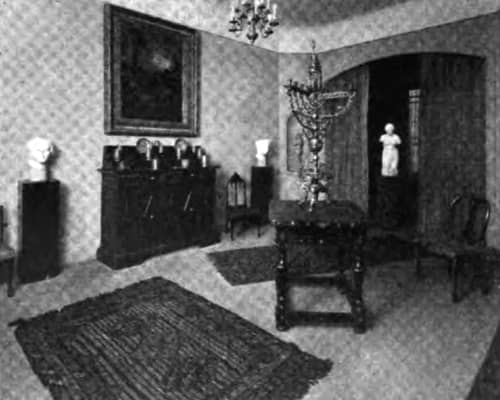
Above: Salon interior at 46 West 57th Street, New York. Interior decorations were done by the Polish painter, Witold Gordon [1885-1968] whom Rubinstein had met in Paris. Gordon elements included the decorative elements in the main and treatment rooms and paintings hung in the salon.
After the armistice was signed in November, 1918, Rubinstein left her sister Mańka and a team of executives in charge of the U.S. business and sailed for Europe to survey her interests there. The war had come at a cost. Some salons, such as those in Petrograd and Constantinople (modern Istanbul) had closed, while others were short of staff and stock. This first post-war trip would be one of many she would make during the 1920s to manage her widespread interests in Australasia, America, Britain and Europe.
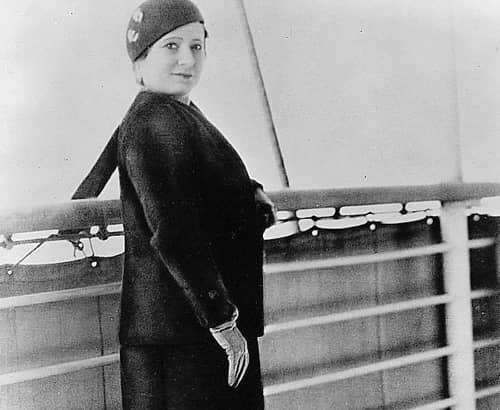
Above: Rubinstein on one of her many transatlantic trips.
In the United States, things had begun to pick up economically after the post-war recession of 1920 and 1921. More women joined the workforce and consequently had money to spend on cosmetics. However, global competition in the beauty industry was also on the rise. Elizabeth Arden [1881-1966] opened her first overseas salon in London in 1922 and she followed that with Paris in 1923, by which time her products were available as far away as Rubinstein’s starting point, Australia.
See also: Elizabeth Arden (1920-1930)
Rubinstein had legally separated from Titus in 1916 but continued to rely on him. He advised her on a number of real estate purchases she made in Paris through her property company France-Am Ltd. (Woodhead, 2003, p. 314). These included a building at 52 Rue du Faubourg Saint-Honoré which would become the site for a second Paris salon in 1927, her other Paris salon having moved from 55 Rue Saint-Honoré to 126 Rue du Faubourg Saint-Honoré in 1921.
Skin-care
Rubinstein’s skin-care range in the 1920s included a number of new lines. Her first important addition was Valaze Pasteurized Facial Cream introduced in 1923. Described as an ideal cleansing, nourishing and massaging cream suitable for all ages, Rubinstein claimed it had been created by a famous Viennese skin specialist.
Valaze Pasteurised Facial Cream: ‘This is the cream of a thousand uses. It is unsurpassed as a cream with which to cleanse, massage and nourish the skin at one time. It is specially prepared so as to be suitable for all ages and all types of skin. It penetrates the pores, ridding them of every impurity. It restores delicate texture to chapped, roughened and scaly skins, and softens and whitens the hands, arms and elbows.”
It is hard to see how ‘pasteurisation’ could add any intrinsic benefits to a skin-care product and the process may have been employed simply to remove microbes and reduce spoilage, the same function it is used for in pasteurised milk. When analysed by the Consumer Institute of America in 1940 it was found to contain lanolin and a large amount of water (“A good greasy cream is what you need”, 1940, p. 47).
In 1930, despite claims that the cream was suitable for all skin types, Rubinstein sold two versions: Pasteurized Face Cream for normal and oily skins; and Pasteurized Face Cream Special for dry skins. She also claimed to use Valaze Pasteurized Face Cream as a base in some of her lipsticks and rouges which suggests that they also contained lanolin.
In 1925, Rubinstein began selling Valaze Water Lily Cream (later known as Water Lily Cleansing Cream). Made with extracts from the buds of water lilies, the product was a high-priced cleanser for the ‘ultra-fastidious woman’ which Rubinstein justified by claiming that it was a ‘skin rejuvenator’.
Valaze Water Lily Cream: “[M]ost delightful and luxurious of all face creams—cleanses wonderfully, enlivens and rejuvenates the skin. Contains youthifying essence of water lily buds.”
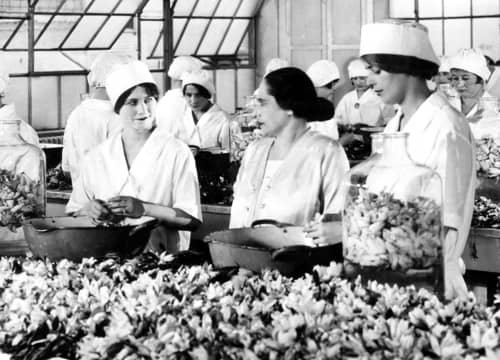
Above: 1924 Women processing water lily buds in the St. Cloud factory in Paris. The flowers appear to be from the European white water lily Nymphaea alba which has a sweet fragrance. After the petals were removed they were placed in large glass bottles along with a solvent to extract the scent.
When fresh and young, these [water lily buds] are gathered from the silent ponds—not only in America, but in France and Italy, too. They form and essence youthifying, rejuvenating and exquisitely sweet and refreshing, which, in Its turn, is used in the smoothest of creams, the finest of lotions, and lately, in a new foundation cream, the consistency of a rich, thick liquid—and as lovely as the fresh buds themselves when they go into its composition.
(Rubinstein advertorial, 1928)
Although water lily extracts had been used in skin creams before it seems likely that Rubinstein was more interested in their exoticism and fragrance. They also enabled her to charge a higher price for any cosmetic made with them, such as her Water Lily Powder, Water Lily Compressed Powder and Water Lily Lipstick (1927); Water Lily Foundation (1928); or Water Lily Rejuvenating Mask and Water Lily Cleansing Lotion (1930). Rubinstein was well aware of the importance of fragrance in selling cosmetics and subsequently bought Crystal-Lee, Inc., a New York perfume company in 1926.
Skin types
For much of the 1920s, Rubinstein would stick to her earlier separation of skin into normal (average), dry and oily, providing her clients with skin-care routines for each. These routines were updated after Valaze Pasteurizing Facial Cream was added in 1923:
DRY SKINS
Night: Cleanse with Valaze Cleansing and Massage Cream which clears away all impurities.
Apply Valaze Grecian Cream (Anthosoros) patting in well around the eyes, and whenever there is any tendency for lines or hollows.
For advanced cases: After cleansing use the highly stimulating Valaze Georgine Lacteé, the muscle and tissue tightener and follow with Valaze Anthosoros Cream.
Day: After cleansing, apply Valaze Skin-toning Lotion Special, a bracing tonic and mild astringent.
AVERAGE SKINS
Cleanse with Valaze Pasteurized Cream, a wonder cream for freshening, revitalizing and youthifying the skin.
Now film the skin with Valaze Beautifying Skinfood which clears, purifies, stimulates and lightens the skin several shades. Leave on for a few minutes before removing.
Complete this beauty treatment with Valaze Skin-toning Lotion to stimulate, brace and close pores, and refine the skin.
OILY SKINS
Night: Wash with Valaze Beauty Grains or Valaze Blackhead and Open Pore Paste both soap substitutes that coax outall impurities and give delightful bud-like fineness to the skin.
Follow with Valaze Beautifying Skinfood (Clear-skin Cream) not a cream to nourish, but a skin awakener and refiner. Leave on for as long as possible, remove and finish with Valaze Liquidine.
Day: Cleanse with Valaze Pasteurized Cream, the only cleansing cream that accomplishes wonders for the oily skin, freshening and revitalizing it.
Finish with Valaze Liquidine, using it also once or twice during the day, especially on the nose and chin, to completely prevent shininess and leave that soft ‘mat’, velvety smoothness.(Rubinstein advertisement (modified), 1925)
The routine was altered again after the introduction of Valaze Water Lily Cream which, being more expensive, now became the preferred option for cleansing dry skin.
Towards the end of the 1920s, Rubinstein’s suggested skin-care routine involved cleansing, stimulating and nourishing the skin before finishing with toning and bracing. For most skin treatments this meant cleansing with one of the Pasteurized Face Creams, stimulating with Valaze Skinfood, nourishing with Grecian Anti-wrinkle Cream (Anthosoros), then bracing and toning with one of the Valaze Skin-toning Lotions. Busy women could use a simpler three-minute treatment that cleansed and refreshed the skin with a Pasteurized Face Cream matched to their skin type, then toned with a suitable Valaze Skin-toning Lotion.
Also see the company booklet: Beauty in the Making (1930)
A major development at the end of the decade was Rubinstein’s introduction of the ‘combination’ skin type. She would later claim to have invented this category and to have first introduced it when she started in Australia in 1902. However, this appears to be another example of her rewriting history as the earliest reference I have for her mentioning combination skin is 1929.
There is a perplexing contrary, skin condition called the “combination skin” nose and chin oily; skin, otherwise dry. Certainly a contradiction in skin type and for it Helena Rubinstein has evolved a perfect, corrective combination skin treatment.
(Rubinstein advertisement, 1929)
Women with combination skin had to treat the areas around the eyes, cheeks and forehead, where the skin was dry, differently to oily areas such as the chin and nose.
[A] complete Combination Skin treatment will use Blackhead and Open Pore Paste Special to cleanse thoroughly; Cleansing and Massage Cream (or Water Lily Cleansing Cream) to soothe and soften; Beautifying Skinfood to clear and whiten; Refining Lotion to correct oiliness; Skin-toning Lotion Special to tone and brace the skin. For excessive oiliness of nose and chin, Liquidine is marvelous.
(Rubinstein advertisement, 1929)
Blackheads, enlarged pores and acne
New additions to this group of cosmetics included Valaze Pomade/Pommade Noire, Valaze Eau d’Or, Valaze Pink Medicated Cream (later known as Valaze Acne Cream) and Valaze Special Acne Paste.
Valaze Pomade Noire: “[F]or skin that is dull, sallow, excessively oily, blemished with obstinate blackheads or acne—or with scars which frequently remain after an acne condition is corrected.”
Valaze Acne Cream (Medicated Pink Treatment): “[H]eals, soothes, and corrects pimples, blotches, blemishes and all disturbed skins.”
Valaze Eau d’Or: “Stimulant of special strength for removing obstinate freckles, moth patches, hard skin substances, whiteheads and such blemishes.”
Valaze Pink Medicated Cream appears to have been made with camphor, sulphur and synthetic calamine, the later ingredient providing the pink tint. Valaze Special Acne Paste and Pomade Noire were strong preparations that could induce skin peeling so may have contained resorcinol and/or salicylic acid. Eau d’Or, a skin bleach, might have gotten its yellow colour from chamomile added as a soothing agent. Pomade Noire was a dark cream so may also have contained ichthammol (ammonium bituminosulfonate), an antibacterial recommended by the German dermatologist Paul Gerson Unna [1850-1929].
Masks
Rubinstein’s first mask was the Valaze Egyptian Mask (1920). The name was fortunate as it enabled Rubinstein to exploit the outbreak of Egyptomania that started when Howard Carter [1874-1939] discovered the tomb of Tutankhamun in 1922. The Egyptian Mask was similar to the other clay masks that were popular in the 1920s and was applied with the finger tips or a small soft brush.
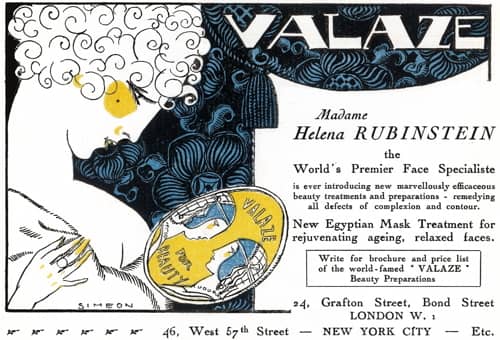
Above:1920 Valaze Egyptian Mask Treatment.
Egyptian Mask: “[S]moothes out lines, gives youthful tension and firmness to the contour, immediately makes mat and clear the tone of the complexion, and helps the face radiate beauty.”
The home treatment involved four preparations so presumably included cleansing, stimulating and nourishing cosmetics as well as the clay.
See also: Clay Masks
In 1930, Rubinstein added two new masks, Grecian Contour Mask for the older woman, and Water Lily Rejuvenating Mask for all skins. Both products came in packs of 15 treatments.
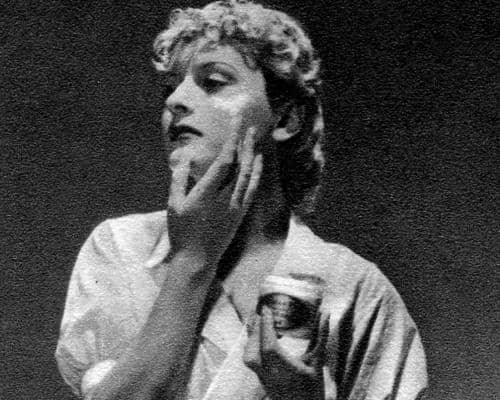
Above: 1935 Water Lily Rejuvenating Mask.
Grecian Contour Mask: “[A] soothing, milky, semi-liquid preparation which … goes on easily and smoothly, tightens sagging muscles, smoothes and refines the texture of the skin. Corrects oiliness almost like magic.”
Water Lily Rejuvenating Mask: “[A] perfect combination of ingredients, it produces a smooth, lovely suppleness without being one bit drying to the most fragile-textured skin.”
Also see the company booklet: Beauty Masks (c.1930)
Make-up
Rubinstein was an early promoter of make-up but made allowances for more conservative views by emphasising the protective value of her face powders and lip cosmetics. As attitudes to ‘paint’ changed during the 1920s, and the use of make-up became more acceptable, Rubinstein extended her range of decorative cosmetics and began to use the term ‘make-up’ more openly.
Face Powders
Valaze Complexion Powder (for average or oily skin) and Novena Poudre (for dry, sensitive skin) continued to be sold during the 1920s. The original shades of Flesh, White, Pink, Cream, Ochre and Mauve were extended becoming Flesh, White, Rose, Natural, Rachel, Ochre and Mauve by 1920 with other shades including Peaches and Cream, Blush, Mauresque, Light Ochre, French Ochre, Deep Ochre, Gypsy Tan (Cote d’Azur) and Dixie Tan added later on. Many of the newer shades were darker, a reflection of the growing vogue of suntanning. Some shades were also made available in other forms; e.g. Gypsy Tan (1929) came as a foundation, powder and liquid powder. Like Elizabeth Arden’s Rosetta-Bronze make-up, the foundation was available in a tube to make it easier to take to the beach.
Gypsy Tan Foundation—An enchanting makeup, vivid, colorful and flattering! Becoming to every type of skin. A sunproof foundation. Easy to apply and remove.
Gypsy Tan Liquid Powder—Transforms the average woman into a glowing personality and enhances the beauty of a perfect complexion.
Gypsy Tan Powder—Exquisitely lovely in tone and texture. Fine and adherent. In a charming dusky shade of tan.(Rubinstein advertisement, 1929)
See also: Elizabeth Arden (1920-1930)
In 1927, as part of the new Water Lily make-up line, Rubinstein introduced Water Lily Face Powder. It came in the same shades as her earlier powders and was sold in both Complexion and Novena formulations making it suitable for all skin types. However, it retailed for a higher price, as did the later Enchanté Face Powder (1928) which came in a Silver (small-sized) or Chinese Temple (large-sized) boxes.
Foundations
Rubinstein had a number of cosmetics that could function as a foundation including the older Valaze Cream of Lilies, Valaze Balm Rose, Valaze Snow Lotion, Valaze Liquidine and Valaze Beauty Foundation Cream. Some older protective cosmetics had disappeared; e.g., Balm Vert and Valaze Creme Promenade but Rubinstein now sold Sun and Windproof Balm, Sun and Windproof Cream, and Sunproof Lotion all of which she recommended as foundations.
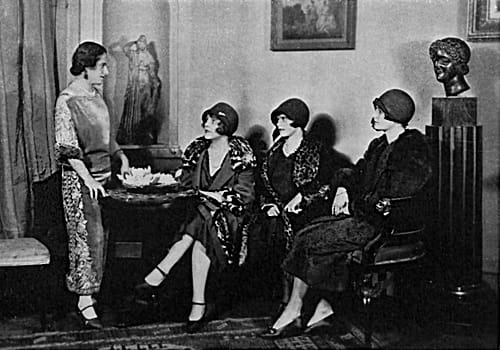
Above: 1925 Helena Rubinstein and clients in the New York salon.
In 1928, Valaze Water Lily Foundation was added but it was only available in one shade, a deep Rachel. Women who preferred a white foundation could either use Valaze Cream of Lilies, which only came in Ivory, or use a suitable shade of Valaze Snow Lotion which now came in White, Natural, Rachel, and Cream shades. For those who wanted to mimic or correct problems associated with tanning there were darker shaded preparations such as the previously mentioned Gypsy Tan.
Lipsticks and rouge
At the start of the decade, Rubinstein sold Valaze Lip Lustre as a stick or salve in three tones, Untinted, Light and Dark, most likely shades with dyes not pigments. Lip Lustre was marketed primarily as a lip protectant with tinted versions adding a little colour to the lips. More adventurous women would have applied as much colour as possible and used Rubinstein’s Valaze Dry Lip-Pencil to shape the outline of their mouth into the then fashionable Cupid’s Bow. Dry Lip-Pencil was also recommended to tint the lobes of the ears and outline the nostrils, make-up tricks Rubinstein undoubtedly picked up from conversations with, or observations of, actresses.
Valaze Lip Lustre: “This emollient protects the delicate outer membranes of the lips from cracks and chapping. Lips that have become dull and blanched. … Valaze Lip lustre with restore the full and rich lip-colour, and add vividness to the mouth.” Shades: Untinted, Light, Dark.
Valaze Dry Lip-Pencil: “It imparts a delicate and lasting tint, and may be used for giving the pretty outline of a ‘Cupid’s Bow.’ For delicately tinting the lobes of the ears and outlining the nostrils it is ideal.”
By 1924, Rubinstein had increased the shade range of Valaze Lip Lustre to Light, Medium, Dark and Flame and the following year she introduced Valaze Lipsticks which, like all the others she introduced in the 1920s, appear to have been indelibles. Valaze Lipsticks came in Red Raspberry (Light, Medium and Dark) and Red Geranium, a brighter shade for evenings. The tints matched Rubinstein’s rouges which she continued to sell as compacts or creams. By 1930, the cream rouge, Rouge en Creme, was only sold in Red Geranium, Red Raspberry and Brunette shades but the Rouge Compact came in Red Geranium, Red Raspberry, Coral, Brunette, Crushed Rose Leaves and Tangerine shades, the last tint added in 1930.
In 1926, Rubinstein introduced the Cupidsbow Lipstick – contoured to help draw a Cupid’s Bow shape on the lips – in two shades, Red Ruby, a medium tint for brunettes or daytime, and Red Cardinal, a lighter tint for blondes or for evening wear. In 1927, these shades were also used in her more expensive Water Lily Lipstick and Water Lily Rouge, both released as part of the Water Lily make-up range.
The compacts are redolent with the true and irresistibly lovely perfume of the water lily, a fragrance which we do not believe is blended Into any other powder or rouge.
(Rubinstein advertisement, 1927)
In 1928, Rubinstein introduced Valaze Cubist Lipstick in a cheaper black and gold, square, push-up case in Red Raspberry (Medium and Light) and Red Geranium shades. In 1930, she added Valaze Enchanté Lipstick, another indelible in Blonde, Brunette and Vivante shades packaged in a more expensive, silver, push-up case.
Eye make-up
Valaze Eyelash Grower and Valaze Crayon for highlighting and lengthening the line of the eyebrows continued to be sold during the 1920s. In 1926, Valaze Persian Eyeblack, a cake mascara in Black and Brown shades, appears to have replaced the older Tablette Indienne and although Rubinstein was still selling Kohol Jet Grains early in the decade, it seems to have been soon phased out.
In 1928, Rubinstein completed her range of eye make-up when she added Valaze Eye Shadow (cream or compressed powder) in Blue (Blue-Green), Brown and Black shades, with Green added the following year.
Also see the company booklet: Eyes Forever Young (c.1928)
Colour coordination
Throughout much of the 1920s Rubinstein had been calling on her clients to express their individuality through make-up. However, Rubinstein’s advice about the art of ‘personality make-up’ inevitably resorted to grouping individuals by type.
See also: Make-up, Personality and Types
Rubinstein’s early make-up recommendations were restricted to the selections of lipstick, rouge and powder. With the addition of eye shadow she was able to provide her clients with complete make-up recommendations based on their complexion, hair and eye colour. Her colour choices were limited but so were most other make-up providers of the day; e.g., in 1928, Max Factor only sold nine shades of face powder, seven shades of rouge, three shades of lipstick and three shades of eye shadow.
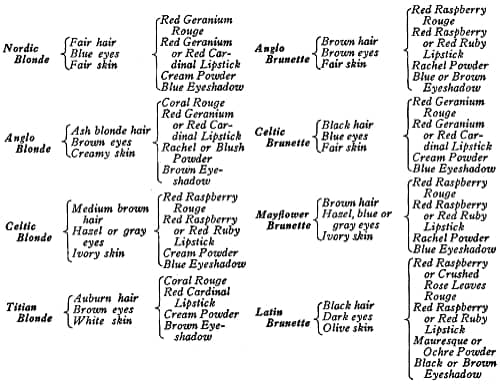
Above: c.1928 Rubinstein make-up recommendations based on types.
Also see the company booklet: Personality Make-up (c.1928)
A simpler recommendation set was developed in 1930.
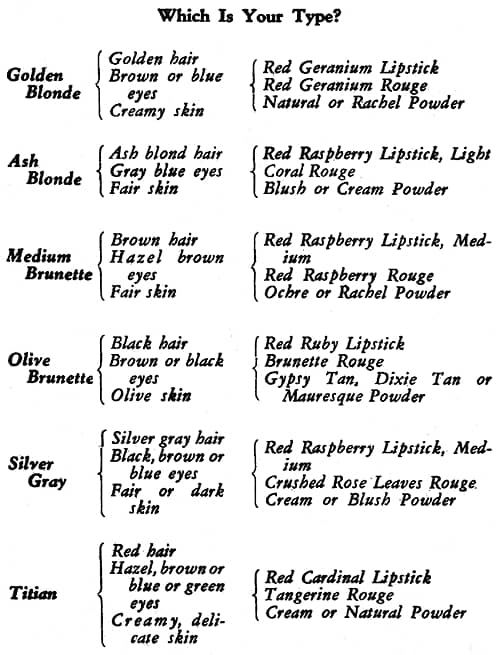
Above: 1930 Rubinstein make-up recommendations based on types incorporating new shades.
Nail cosmetics
By 1929, Rubinstein had a true nail polish in her range along with a remover. Called Valaze Nail Groom it appears to have been scented with Water Lily fragrance. Initially, it may have been untinted but, by 1930, it came in Shell Pink, Red Geranium and Red Raspberry – probably coloured with dyes not pigments – enabling women to match their nail polish with Rubinstein’s Valaze Lipsticks.
Valaze Nail Groom: “[S]preads on evenly and lastingly! It imparts a delicate, shell-like beauty to the nail. Waterproof, too and will neither crack nor peel.”
Other developments
In 1926, Rubinstein transfered her American manufacturing base from 208 Rawson Street to larger facilities at 65-73 First avenue, Long Island city. The executive offices at 46 West 57th Street were also in need of extra space and they were moved to larger quarters in the same building.
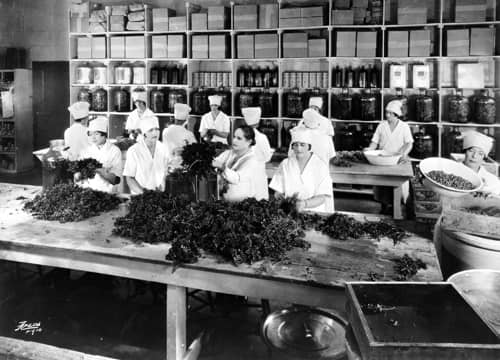
Above: c.1930 Women processing parsley (front table) and grapes (back table) in the Rubinstein factory in Long Island City. The grapes were used in astringent lotions.
Grapes, too, from the sunkissed vineyards of Spain and Italy, come in wild profusion and are first put into wire boxes, sprayed thoroughly picked over by hand, washed again and again by electric power and by hand, until they are fresh and scrupulously clean. Then they go to a great press which coaxes the little rivulets of sweet, astringent juice from them, and later passes it on to be combined with other spices and balsams and blended into the finest of lotions.
(Rubinstein advertorial, 1928)
In Paris, Rubinstein had been operating from her Insitut de Beauté Valaze at 126 Rue du Faubourg since 1921.
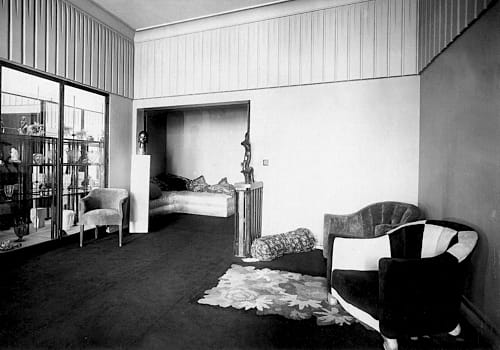
Above: Interior of the salon at 126 Rue du Faubourg designed by Paul Poiret [1879-1944].
In 1927, Rubinstein opened a new Paris salon along the road at 52 Rue du Faubourg. However, instead of naming it an Insitut de Beauté Valaze, Rubinstein referred to it as the Clinique de Beauté Helena Rubinstein, presumably to help distinguish it from the large number of other Beauté Instituts then operating in Paris.

Above: Clinique de Beauté Helena Rubinstein.
In the same year, Rubinstein commissioned the modernist architect Ernö Goldfinger [1902-1987] to modernise the London salon in Grafton Street. Rubinstein thought his plans too extreme and they were scaled back considerably. She also initially refused to pay him and the dispute went to court (Slesin, 2003, p.44).
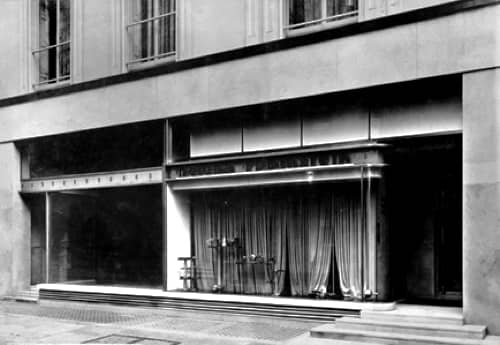
Above: c.1928 Refurbished Helena Rubinstein salon at 24 Grafton Street, London. The building was destroyed by German bombing during the Second World War.
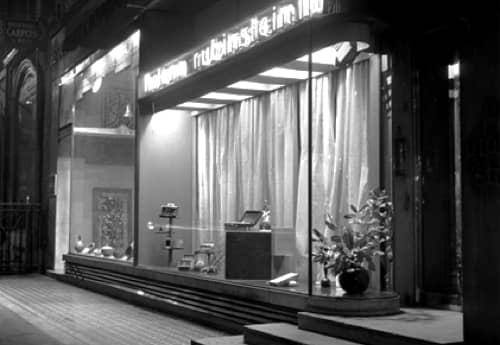
Above: 1936 Night view of the Helena Rubinstein salon at 24 Grafton Street, London showing neon lighting.
In 1928, Rubinstein moved her New York salon to 8 East 57th Street, a building she had visited when it operated as an art gallery run by Georges-Joseph Demotte [1877-1923].
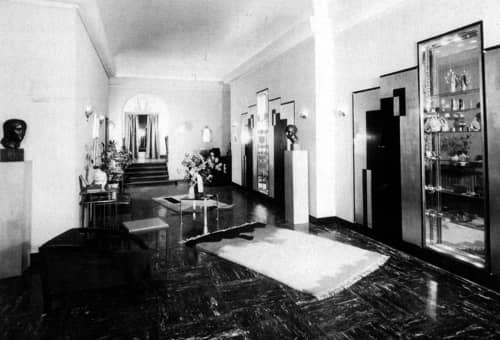
Above: Interior of the salon at 8 East 57th Street, New York designed by Paul T. Frankl [1886-1958] assisted by Donald Desky [1894-1989]. Frankl had previously worked on the salon at 15 East 49th Street.
In 1926, Rubinstein incorporated her American business and, in December, 1928, she sold a large part of it to Lehman Brothers for a reported US$7,300,000. She later claimed that she did not do it for the money but rather to save her marriage to Titus.
I sold the American corporation for one reason only—to save my marriage. It was a sacrifice, for my business had always meant more to me than money. Besides, every instinct told me that bankers would have neither the training not the intuition necessary to operate a cosmetic company. I felt there was no alternative, however.
(Rubinstein, 1965, p. 72)
A new corporation was formed to take over the older Helena Rubinstein, Inc. and shares in the new company were offered through Bauer, Progue, Pond & Vivian of New York. Rubinstein owned 44% of the issued common stock of the new company and was made the company president. The general manager of the new corporation was Charles S. Welch who had previously worked for Houbigant and Rallet. Included in the purchase was the American manufacturing business which had its name changed to the H. J. T. Beauty Products Manufacturing Company. The initials appear to come from Helena J. Titus, Helena remaining married to Titus until 1938.
Net earnings for the company were US$958,947 in 1928 and the future looked bright for the new enterprise which aimed to increase profits by entering into the volume market. This meant that Helena Rubinstein products could go somewhat downmarket but it was thought that the line’s prestige would be maintained through the image of Helena Rubinstein as president of the company.
Unfortunately, the stock market crashed in October, 1929, and the stock price of the company fell dramatically. Undeterred, the company persisted with its strategy of increasing volumes and, in 1930, repackaged many lines and introduced a number of new cosmetics including Valaze Contour Jelly, Grecian Contour Mask, Water Lily Rejuvenating Mask, Water Lily Cleansing Lotion, Youthifying Tissue Cream, Youthifying Hand Cream and Enchanté Lipstick. However, as the 1929 recession turned into the Great Depression, the volume strategy floundered in the face of reduced demand. Rubinstein became increasingly unhappy with the direction of the American business and began plotting to regain control of the company.
Timeline
| 1915 | Salon opened in New York. New Products: Valaze Beauty Grains; and Valaze Bleaching Cream. |
| 1916 | Helena Rubinstein Beauty Products Manufacturing Company established in New York. Salons opened in San Fransisco, Philadelphia, and New Orleans. |
| 1917 | Product manufacturing started in the United States. Salon opened in Chicago. |
| 1918 | New York salon moves to 46 West 57th Street. Salon opened in Atlantic City. |
| 1920 | Salon opened in Boston. New Products: Valaze Pink Medicated Cream; and Valaze Egyptian Mask. |
| 1921 | Paris salon moved to 126 Rue du Faubourg Saint-Honoré. |
| 1923 | New Products: Valaze Pasteurized Facial Cream; and Valaze Theatrical Cream. |
| 1925 | New Products: Valaze Water Lily Cream; and Valaze Lipsticks. |
| 1926 | American business incorporates. American manufacturing transferred to 65-73 First Avenue, Long Island City. Acquires Crystal Lee, Inc. New Products: Cupidsbow Lipstick; and Valaze Persian Eyeblack. |
| 1927 | New York offices moved to 8 East 57th Street. Salon opened in Milan. New Paris salon opened at 52 Rue du Faubourg Saint-Honoré. New Products: Water Lily Powder; Water Lily Compressed Powder; and Water Lily Lipstick. |
| 1928 | New York salon moves to 8 East 57th Street. London salon renovated and expanded. Control of the American business sold to Lehman Brothers. Helena Rubinstein Beauty Products Manufacturing Company becomes H. J. T. Beauty Products Manufacturing Company. Salon opened in Vienna. New Products: Valaze Eye Shadow; Water Lily Foundation; Enchanté Face Powder; and Cubist Lipstick. |
| 1929 | Établissements Helena Rubinstein founded in Paris. Factory opened in Toronto. Syndicated radio broadcasting begins on NBC. Salons opened in Madrid, Boston, Detroit, and Toronto. New Products: Valaze Contour Jelly. |
| 1930 | New Products: Grecian Contour Mask; Water Lily Rejuvenating Mask; Water Lily Cleansing Lotion; Youthifying Stimulant; Youthifying Tissue Cream; Youthifying Hand Cream; and Enchanté Lipstick. |
Continue to: Helena Rubinstein (1930-1945)
First Posted: 18th September 2017
Last Update: 17th April 2023
Sources
Beckley, Z. (1918). New York woman, judged on “points,” more beautiful that Parisian type. The Evening World, December 27.
A good greasy cream is what you need. (1940). Consumers’ Digest. VII(4), October, 44-47.
Fabe, M. (1972). Beauty millionaire. The life of Helena Rubinstein. New York: Thomas Y. Crowell Company.
Helena Rubinstein. (c.1915). Beauty in the making [Booklet]. USA: Author.
Helena Rubinstein. (c.1921). The secrets of beauty [Booklet]. USA: Author.
Helena Rubinstein. (c.1928). Personality make-up [Booklet]. UK: Author.
Helena Rubinstein. (c.1928). Eyes forever young [Booklet]. USA: Author.
Helena Rubinstein. (1930). Beauty in the making [Booklet]. USA: Author.
O’Higgins, P. (1971). Madame: An intimate biography of Helena Rubinstein. New York: The Viking Press.
Rubinstein, H. (1930). The art of feminine beauty. New York: Horace Liveright, Inc.
Rubinstein, H. (1965). My life for beauty. Sydney: The Bodley Head Ltd.
Sagarin, E. (Ed.). (1957). Cosmetics: Science and technology. New York: Interscience Publishers, Inc.
Slesin, S. (2003). Over the top: Helena Rubinstein extraordinary style, beauty, art, fashion design. New York: Pointed Leaf Press.
Woodhead, L. (2003). War paint. Miss Elizabeth Arden and madame Helena Rubinstein their lives, their times, their rivalry. London: Virago Press.
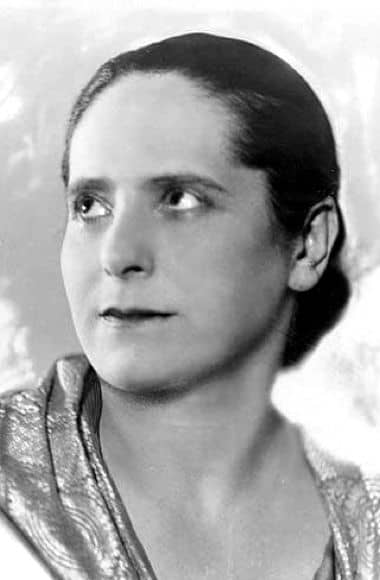
Helena Rubinstein [1871-1965].
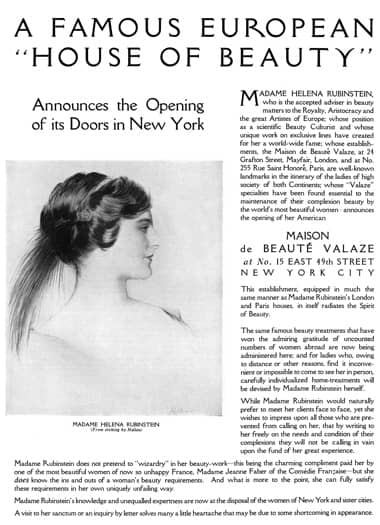
1915 Helena Rubinstein announcing the opening of her New York salon.
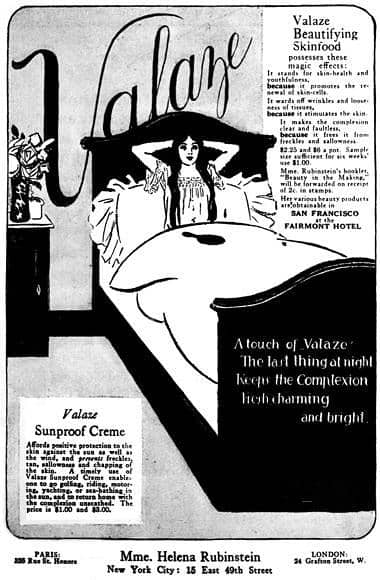
1915 Helena Rubinstein Valaze.
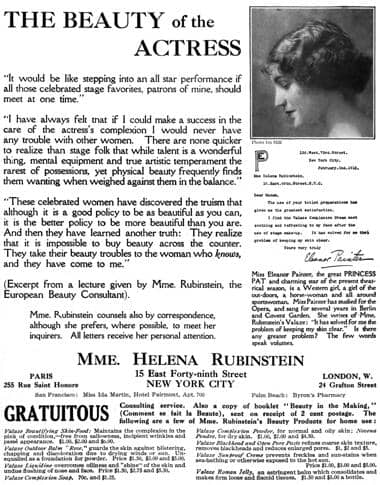
1916 Helena Rubinstein endorsement from Eleanor Painter [1885-1947].
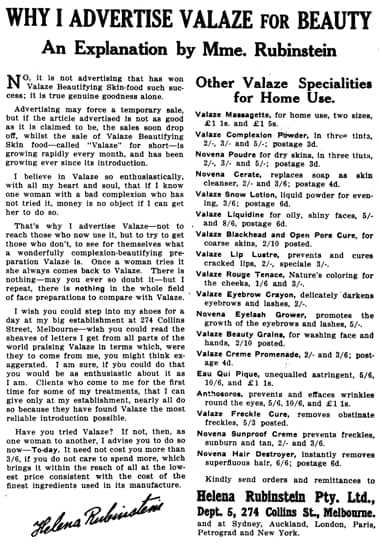
1917 Helena Rubinstein.

1918 Helena Rubinstein—Beauty and the Individual Ideal.
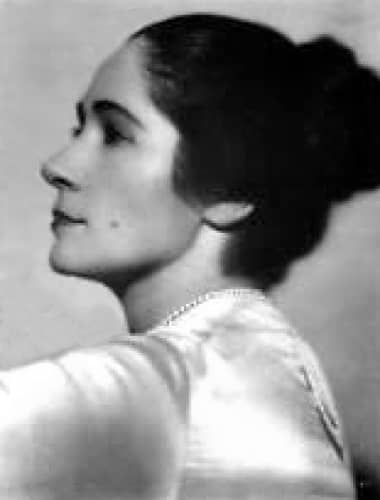
Mańka Rubinstein [1885-?]. Helena and Mańka would fall out when Mańka tried to set up her own cosmetics business in New York in 1926 but the relationship was patched up and she was soon working for her sister once again.
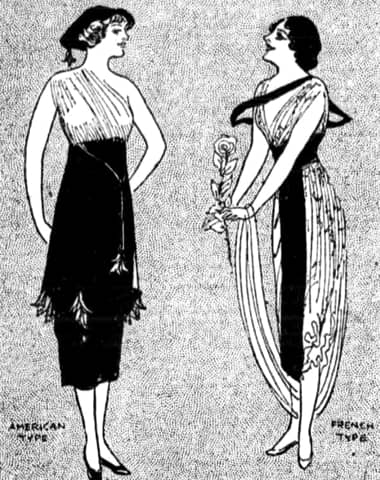
1918 Helena Rubinstein’s flattering comparison of New York and Parisian women. New York women’s points of beauty superiority are: 1 Skin; 2 Throat; 3 Teeth; 4 Figure. Parisenne women’s points of greater pulchritude are: 1 Eyes; 2 Animation; 3 Instinct for Color (Beckley, 1918).
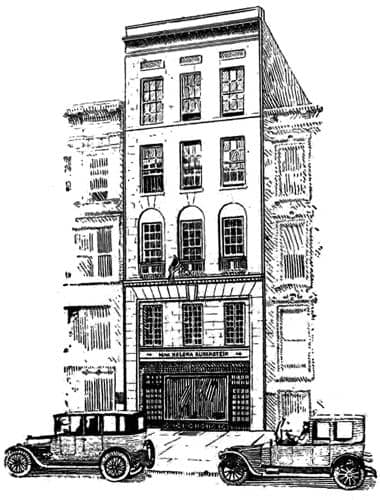
1919 Drawing of the new Maison de Beauté Valaze at 46 West 57th Street, New York. The exterior was painted white with the window grills and Rubinstein’s name across the front in bright green.
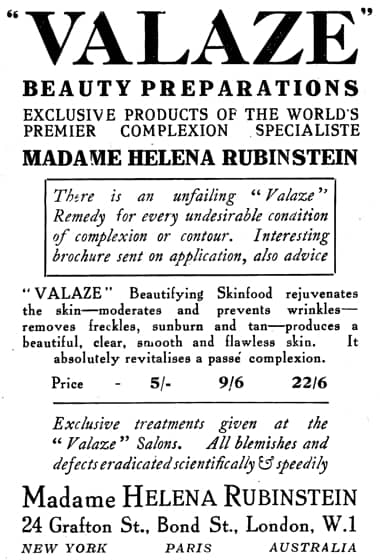
1919 Helena Rubinstein Valaze.
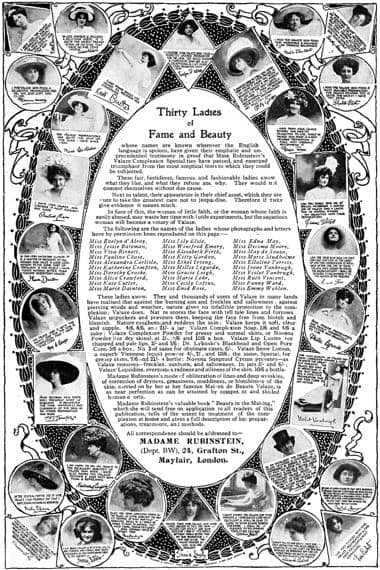
1919 Helena Rubinstein endorsements.
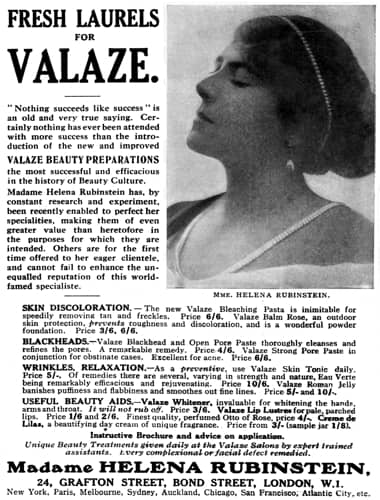
1919 Helena Rubinstein Valaze Beauty Preparations.
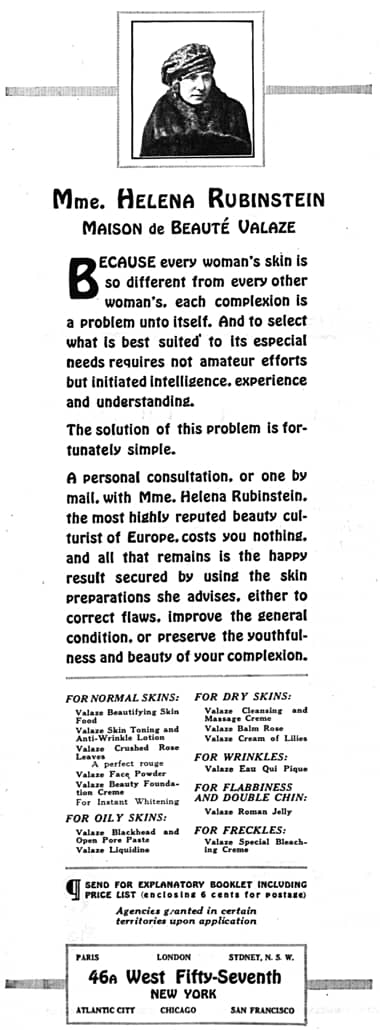
1919 Helena Rubinstein Maison de Beauté Valaze.
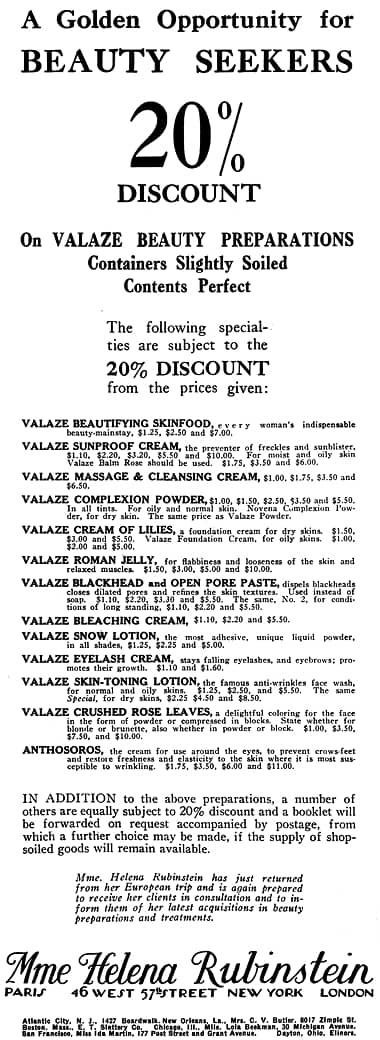
1920 Helena Rubinstein sale items. Business was slow in the early years of the 1920s.
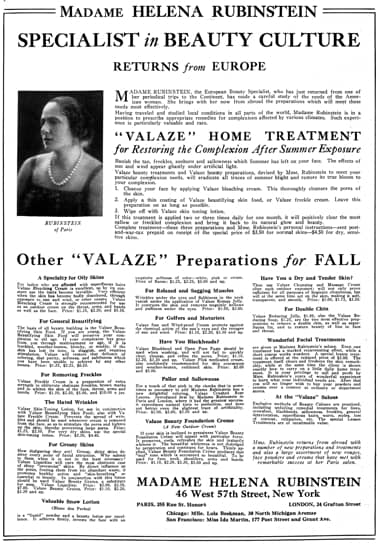
1920 Helena Rubinstein Valaze preparations for autumn.
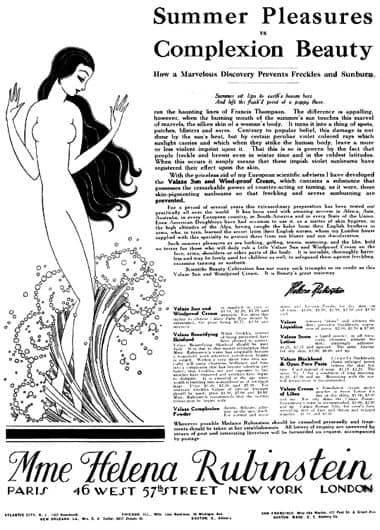
1920 Helena Rubinstein Valaze preparations for summer.
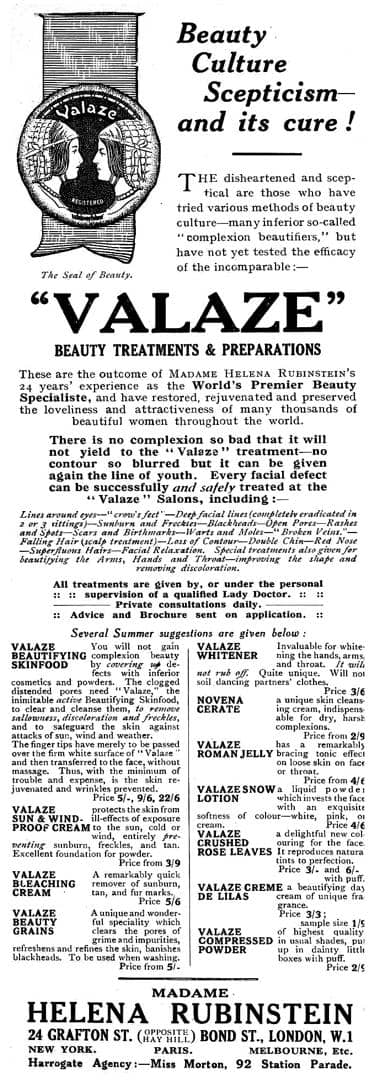
1921 Helena Rubinstein Valaze. The trademarked Seal of Beauty was used as early as 1909 when it was known as the Stamp of Beauty. A modern version of the seal appeared in the American market just after the First World War ended.
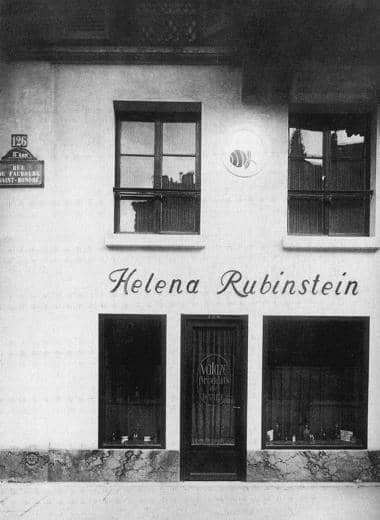
Maison de Beauté Valaze at 126 Rue du Faubourg Saint-Honoré.
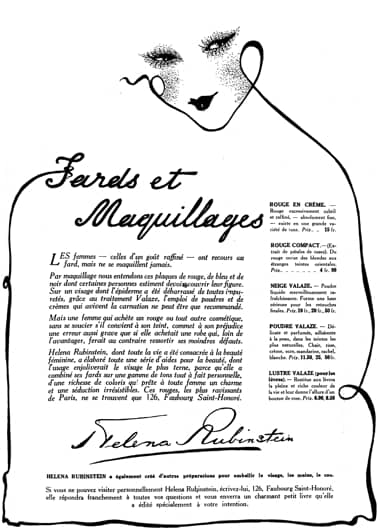
1922 Helena Rubinstein – Fards et Macquillages.
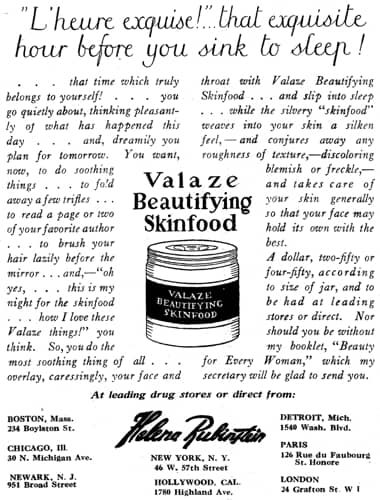
1924 Helena Rubinstein Valaze Beautifying Skinfood.
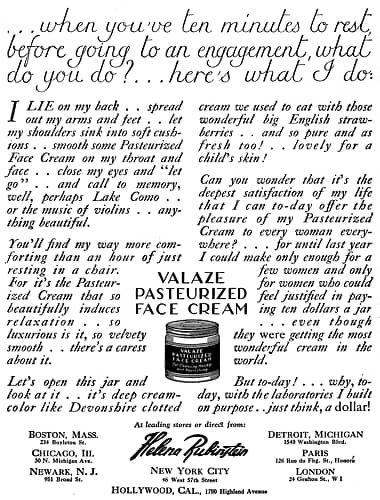
1924 Helena Rubinstein Valaze Pasteurized Face Cream.
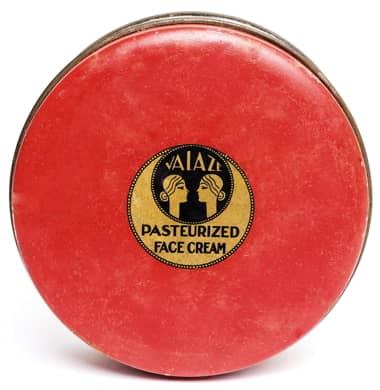
Helena Rubinstein Valaze Pasteurized Face Cream box.
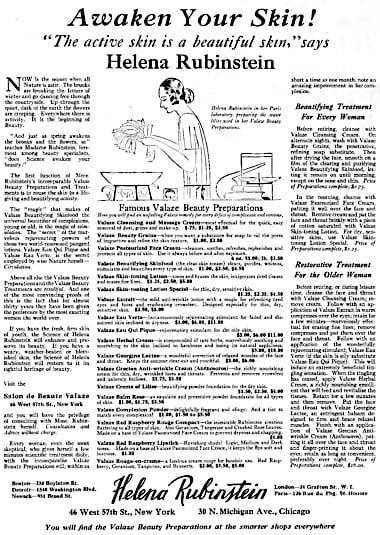
1925 Helena Rubinstein – Awaken your skin!
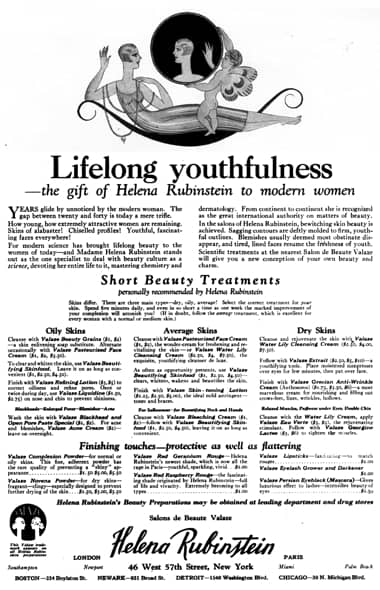
1925 Helena Rubinstein treatments for Oily, Average and Dry skin types.
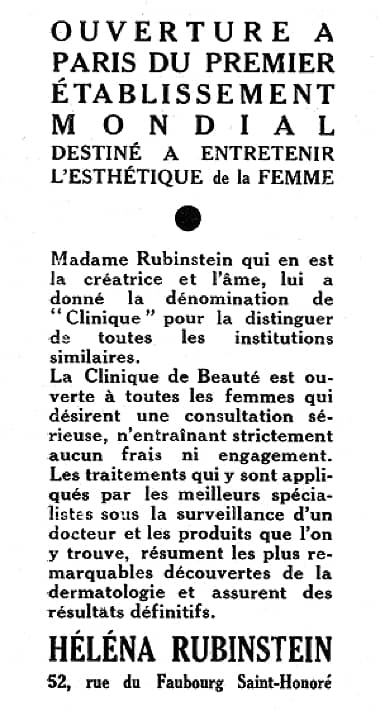
1926 Helena Rubinstein announcing she would be opening a new salon at 52 Rue du Faubourg Saint-Honoré. Loosely translated the advertisement states: “Madame Rubinstein, who is its creator and soul, called her new establishment a “clinic” to distinguish it from all similar institutions.
The Beauty Clinic is open to all women who wish a serious consultation, involving no fees or commitment. Treatments are conducted by the best specialists under the supervision of a doctor and the products used come from the most remarkable dermatological discoveries and give definite results.”
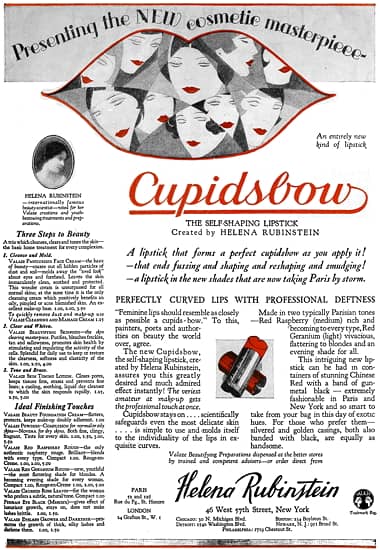
1926 Cupidsbow Self-Shaping Lipstick.
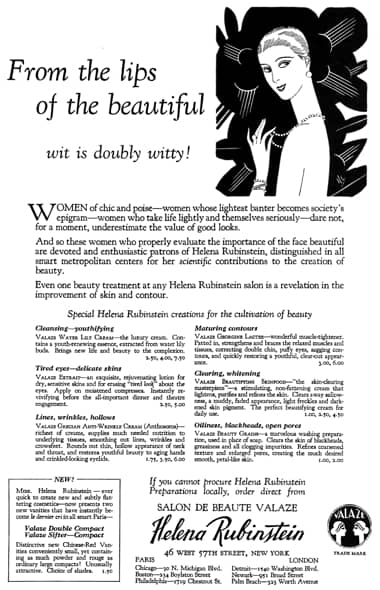
1926 Helena Rubinstein – From the lips of the beautiful.
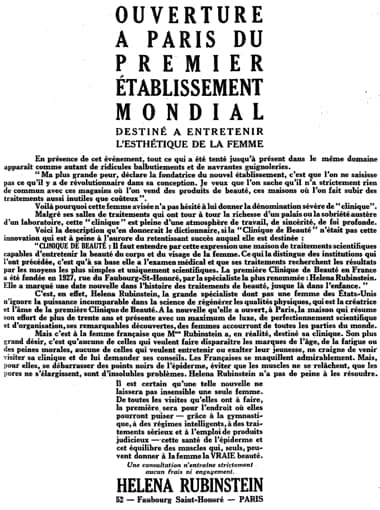
1927 Clinique de Beauté Helena Rubinstein in Paris. The cross-shaped design of this advertisement emphasised the ‘medical’ nature of the salon. Electrotherapy treatments were under the direction of a ‘Doctoresse en Chef de la Clinique’.
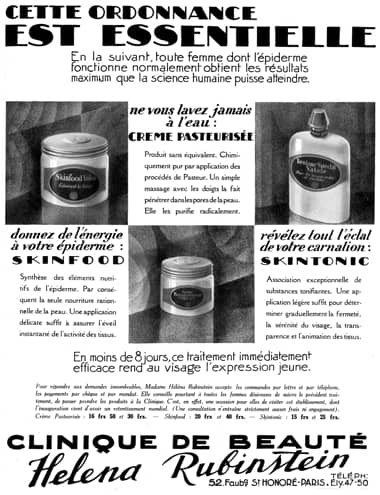
1927 Helena Rubinstein Skinfood, Skin Tonic and Creme Pasteriseée.
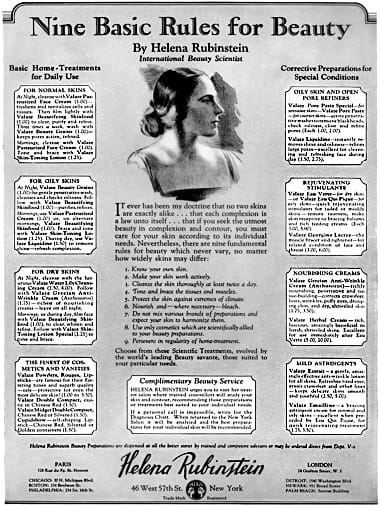
1927 Helena Rubinstein Nine Basic Rules for Beauty.
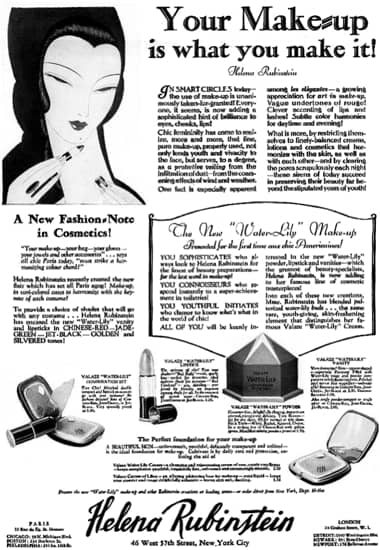
1927 Helena Rubinstein Water Lily Make-up.
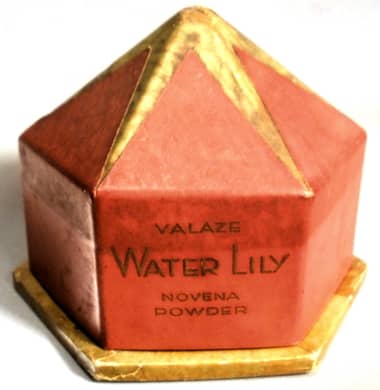
Valaze Water Lily Novena Powder in a red and gold box. The box was design patented in 1927.
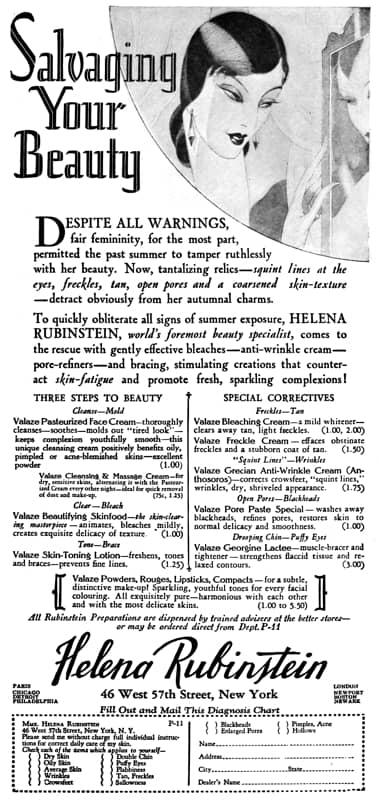
1927 Helena Rubinstein – Salvaging your beauty.
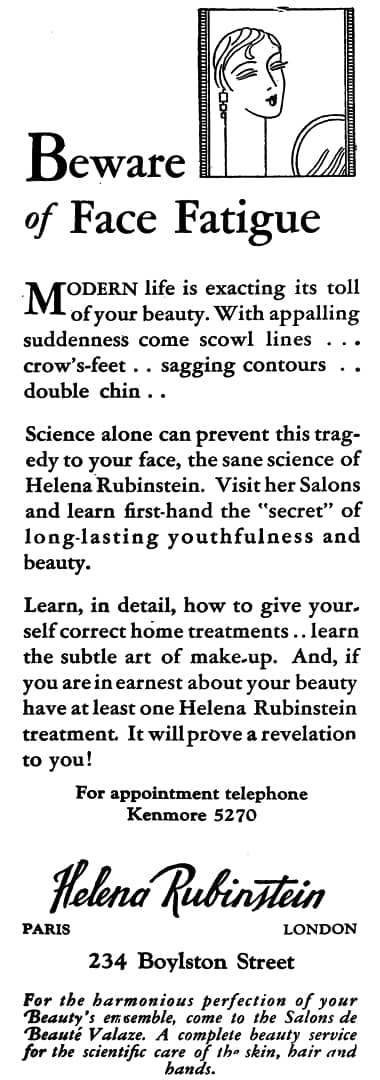
1928 Helena Rubinstein – Beware of face fatigue.
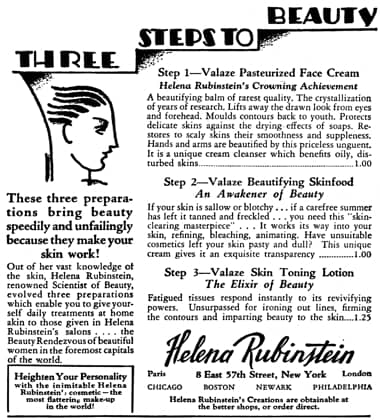
1928 Helena Rubinstein – Three steps to beauty.
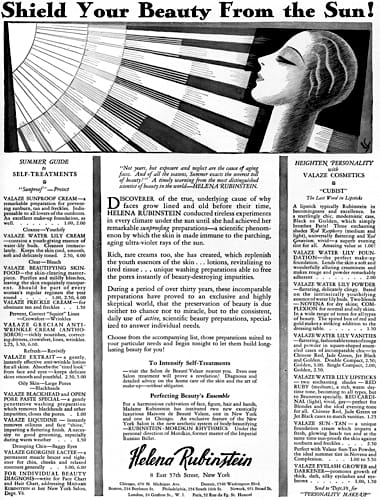
1928 Helena Rubinstein – Shield your beauty from the sun.
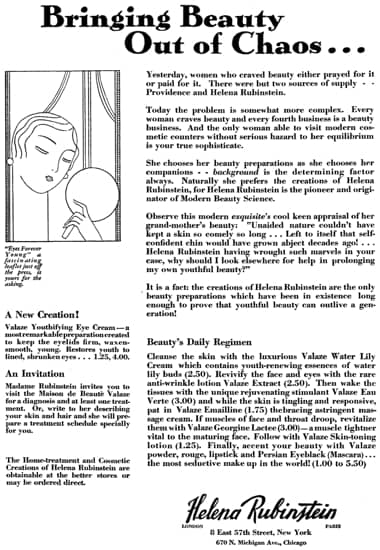
1928 Helena Rubinstein – Bringing Beauty out of Chaos.
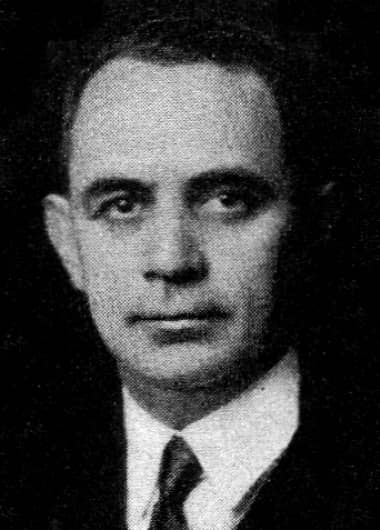
Charles S. Welch. Made general manager of Helena Rubinstein, Inc. in 1928. He left a position as general manager of the Rallet Corporation of America, a subsidiary of Coty, to take up this new position. He resigned in 1930 after Rubinstein sold the American company but returned after she regained control.
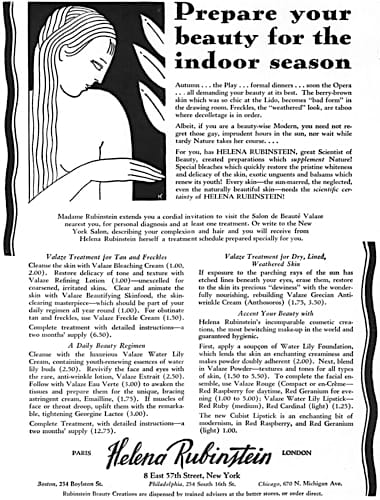
1928 Helena Rubinstein – Prepare your beauty for the indoor season.
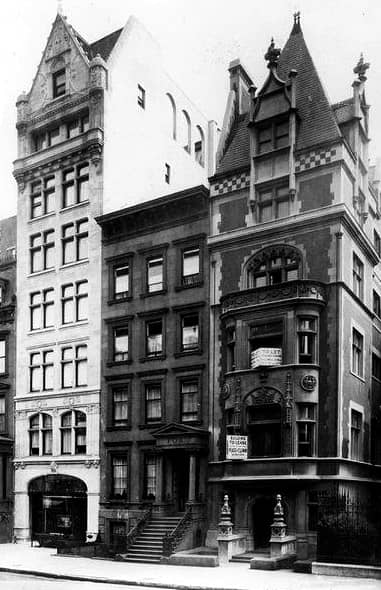
c.1910. Buildings on East 57th Street. The building on the right would become the Demotte Gallery before being taken over by Helena Rubinstein for a new salon in 1928.
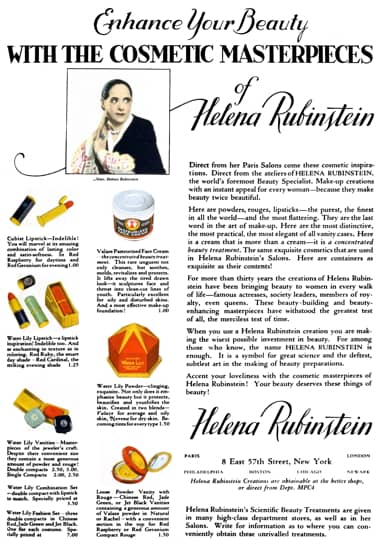
1929 Helena Rubinstein – Cosmetic masterpieces.
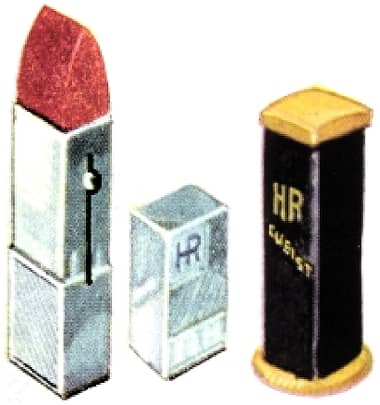
1930 Drawings of Enchanté (left) and Cubist (right) Lipsticks.
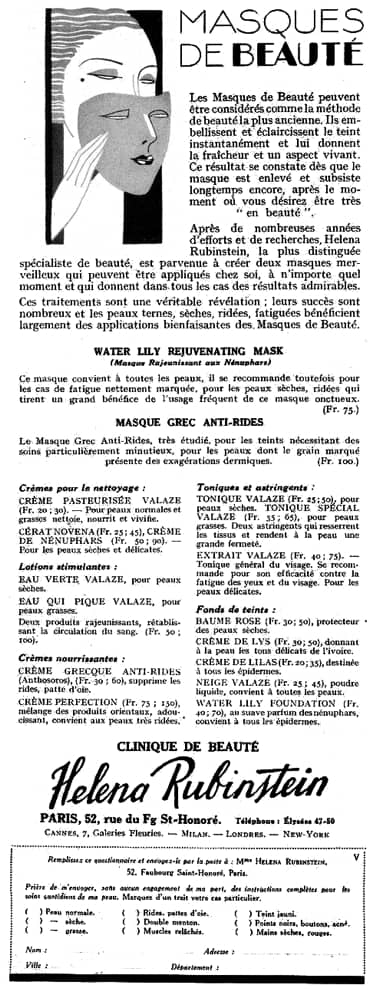
1930 Helena Rubinstein – Masques de beauté.
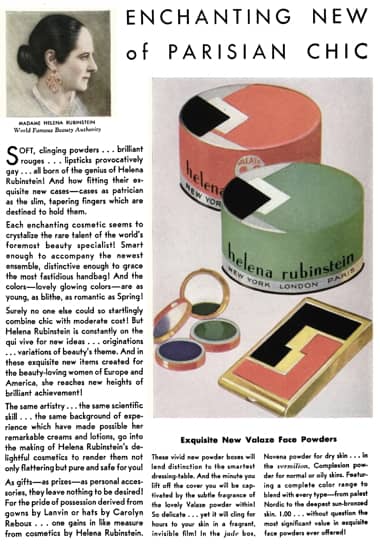
1930 Helena Rubinstein (left page). New powder boxes, eye shadow and compressed powder cases.
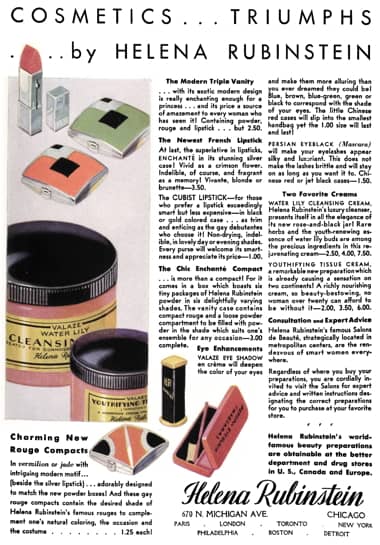
1930 Helena Rubinstein (right page). New jars, compacts and lipstick cases.
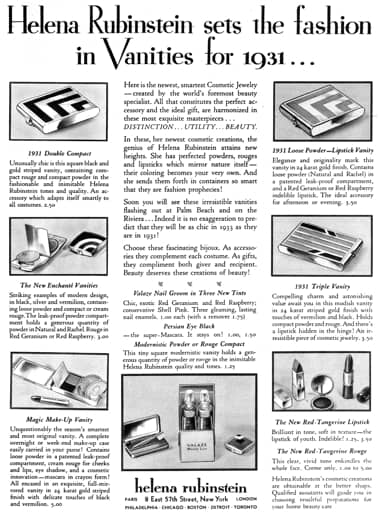
1930 Helena Rubinstein Vanities.
